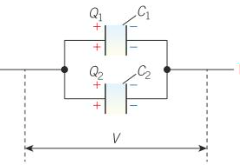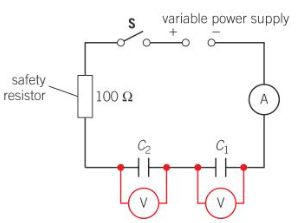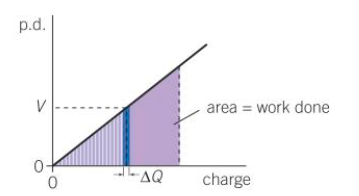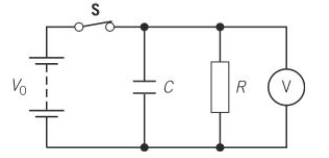Chapter 21: Capacitance
1/16
There's no tags or description
Looks like no tags are added yet.
Name | Mastery | Learn | Test | Matching | Spaced |
|---|
No study sessions yet.
17 Terms
Capacitor
An electrical component
Comprises two metal plates separated by an insulator
Stores charge
Storing Charge
When capacitor is connected to a cell
Electrons briefly flow from cell
Cannot travel between plates because of insulating material
Very brief current means:
Electrons are removed from first plate (acquires positive charge)
Electrons deposited to second plate (acquires negative charge)
Current is equal throughout circuit, so charge is conserved:
plates have equal but opposite charge Q+ and Q-
Current falls to zero when p.d across plates = e.m.f of the cell
Capacitor is fully charged
Capacitance
Charge stored per unit p.d across a capacitor
C = Q / V
Capacitors in Parallel
p.d across each capacitor is the same
Charge is conserved → Total charge = Sum of individual charges
Total Capacitance = C1 + C2 + C3…

Capacitors in Series
Kirchoff’s Second Law→p.d across the combination = sum of individual p.d’s = V1 + V2 + V3…
Charge stored by each capacitor is the same
Total capacitance is given by 1/C1 + 1/C2 + 1/C3 …
Investigating Capacitance
Circuit diagram is set up, with capacitance of each capacitor known
Switch closed → Current is briefly registered but quickly settles to zero
Electrons move in circuit only until capacitor is fully charged
V1 and V2 of each capacitor can be taken from the voltmeters
Changing the fixed resistor has no effect on the charges stored

Energy stored by a capacitor
Work is done to overcome the electrostatic forces from the electrons on the negatively charged plate
This pushes an electron from the positively charged plate to the negatively charged plate,
This is provided by the battery
Potential Difference-Charge graphs
x-axis: Q
y-axis: V
Area = Energy stored
W = ½ QV

Energy equations
W = ½ QV
W = ½ V2C
W = ½ Q2 / C
Discharging a Capacitor
Switch is initially closed and capacitor is fully charged
When switch is opened at t = 0:
V across the capacitor = V0
Current in resistor = V0 / R
Charge stored in capacitor = V0C
capacitor discharges
Charge stored decreases with time
Thus, V decreases with time
Thus, Current in resistor decreases with time
Eventually V and Q of Capacitor and I in resistor = 0

V/Q/I against time
V = V0e-t/CR
I = I0e-t/CR
Q = Q0e-t/CR

Time Constant
CR = Capacitance x Resistance
Same units as time
Time it takes for V/Q/I to decrease to e-1 of its initial value
Modelling exponential decay
Q = VC → V = Q/C
I = V/R →I = (Q/C) / R
I = V/R = Q/CR
I = -ΔQ/Δt = -Q/CR
Q = Q0e-t/CR is a solution for the equation
Iterative modelling
Use equation ΔQ/Δt = -Q/CR
Start with Q0 and known value for CR
Choose a time interval, Δt, which is very small compared to CR
ΔQ = Δt/CR x Q → Charge leaving capacitor
Q - ΔQ = charge left in capacitor → Sub into equation again
Repeat for subsequent multiples of the time interval Δt
Charging Capacitors
Switch is closed, Capacitor charges up
Potential Difference across Capacitor increases
Kirchhoff’s 2nd law →Vc + VR = V0
Thus, as VC increases, VR decreases’
Current decreases exponentially
After a long time (depending on CR), Capacitor is fully charged
potential difference of Capacitor = V0
VR = 0
At this point, I = 0
Current / p.d in a charging capacitor
I = I0e-t/CR
Since V = IR
VR = V0e-t/CR
Since V0 = VC + VR
V0 = VC + V0e-t/CR → VC = V0 - V0e-t/CR
VC = V0(1 - e-t/CR)